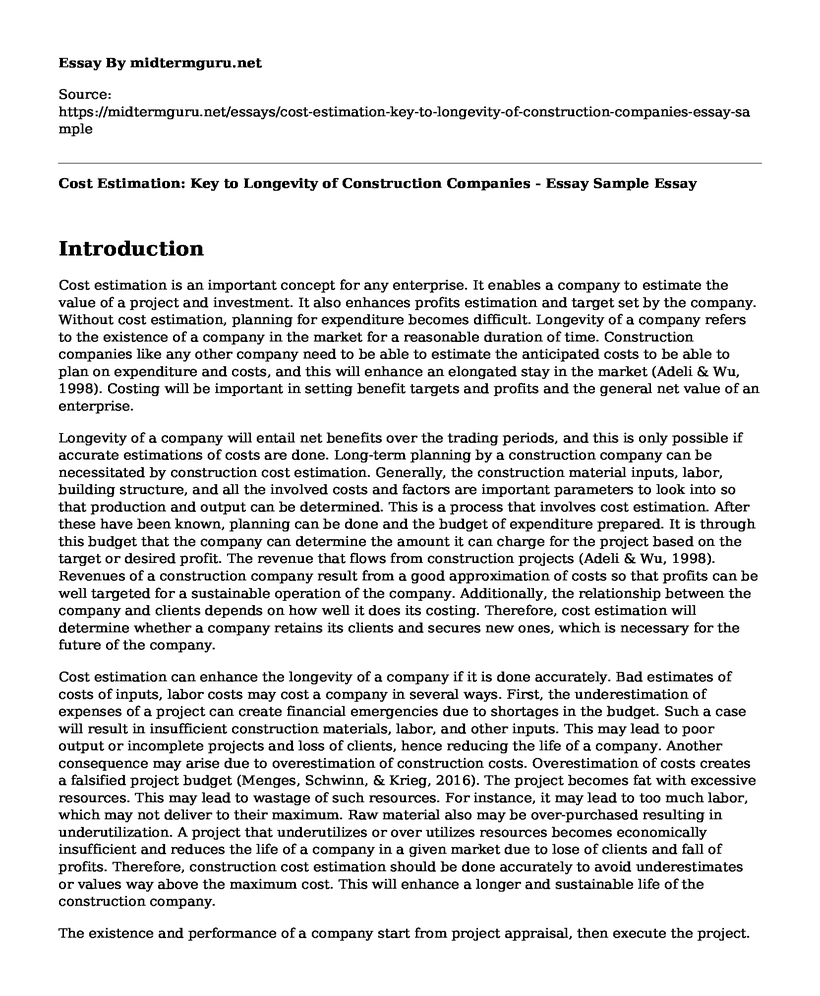Introduction
Cost estimation is an important concept for any enterprise. It enables a company to estimate the value of a project and investment. It also enhances profits estimation and target set by the company. Without cost estimation, planning for expenditure becomes difficult. Longevity of a company refers to the existence of a company in the market for a reasonable duration of time. Construction companies like any other company need to be able to estimate the anticipated costs to be able to plan on expenditure and costs, and this will enhance an elongated stay in the market (Adeli & Wu, 1998). Costing will be important in setting benefit targets and profits and the general net value of an enterprise.
Longevity of a company will entail net benefits over the trading periods, and this is only possible if accurate estimations of costs are done. Long-term planning by a construction company can be necessitated by construction cost estimation. Generally, the construction material inputs, labor, building structure, and all the involved costs and factors are important parameters to look into so that production and output can be determined. This is a process that involves cost estimation. After these have been known, planning can be done and the budget of expenditure prepared. It is through this budget that the company can determine the amount it can charge for the project based on the target or desired profit. The revenue that flows from construction projects (Adeli & Wu, 1998). Revenues of a construction company result from a good approximation of costs so that profits can be well targeted for a sustainable operation of the company. Additionally, the relationship between the company and clients depends on how well it does its costing. Therefore, cost estimation will determine whether a company retains its clients and secures new ones, which is necessary for the future of the company.
Cost estimation can enhance the longevity of a company if it is done accurately. Bad estimates of costs of inputs, labor costs may cost a company in several ways. First, the underestimation of expenses of a project can create financial emergencies due to shortages in the budget. Such a case will result in insufficient construction materials, labor, and other inputs. This may lead to poor output or incomplete projects and loss of clients, hence reducing the life of a company. Another consequence may arise due to overestimation of construction costs. Overestimation of costs creates a falsified project budget (Menges, Schwinn, & Krieg, 2016). The project becomes fat with excessive resources. This may lead to wastage of such resources. For instance, it may lead to too much labor, which may not deliver to their maximum. Raw material also may be over-purchased resulting in underutilization. A project that underutilizes or over utilizes resources becomes economically insufficient and reduces the life of a company in a given market due to lose of clients and fall of profits. Therefore, construction cost estimation should be done accurately to avoid underestimates or values way above the maximum cost. This will enhance a longer and sustainable life of the construction company.
The existence and performance of a company start from project appraisal, then execute the project. This requires several steps, which all revolve around costs involved. Construction financing, inspection of the site, furnishing, and feasibility studies are also necessary for a construction company during project appraisal (Bisetti et al. 2017). These are only possibly done after cost estimation. More importantly, Cost estimation determines investment and financing decisions. Quantity takeoff, labor hours, material prices and indirect costs are significant estimates that a construction company needs for planning. Therefore, construction cost planning helps the growth of a company through avoidance of wastage of resources, incomplete projects, earning and maintenance of client trust, and above all realizations of reasonable profits that can steer the company to higher levels of growth.
References
Adeli, H., & Wu, M. (1998). Regularization neural network for construction cost estimation. Journal of construction engineering and management, 124(1), 18-24.
Ashworth, A., & Perera, S. (2015). Cost studies of buildings. Routledge.Bisetti, E., Favero, C. A., Nocera, G., & Tebaldi, C. (2017). A multivariate model of strategic asset allocation with longevity risk. Journal of Financial and Quantitative Analysis, 52(5), 2251-2275.
Menges, A., Schwinn, T., & Krieg, O. D. (Eds.). (2016). Advancing wood architecture: a computational approach. Routledge.
Cite this page
Cost Estimation: Key to Longevity of Construction Companies - Essay Sample. (2022, Dec 26). Retrieved from https://midtermguru.com/essays/cost-estimation-key-to-longevity-of-construction-companies-essay-sample
If you are the original author of this essay and no longer wish to have it published on the midtermguru.com website, please click below to request its removal:
- BC Tillamook Cheese Company Paper Sample
- 4 Finger company in Singapore - Analysis Paper Example
- Essay Sample on Organizational Culture at Coca-Cola Company
- Analysis of DeFond and Zhang's View - Essay Sample
- Ethics in Communication: Ensuring Authentic Communication for Businesses - Essay Sample
- Behavioral Finance: Psychology of Investors and Market Impact - Essay Sample
- Evaluation Plan: Control Risk, Improve Strategy & Outperform Competitors - Essay Sample







